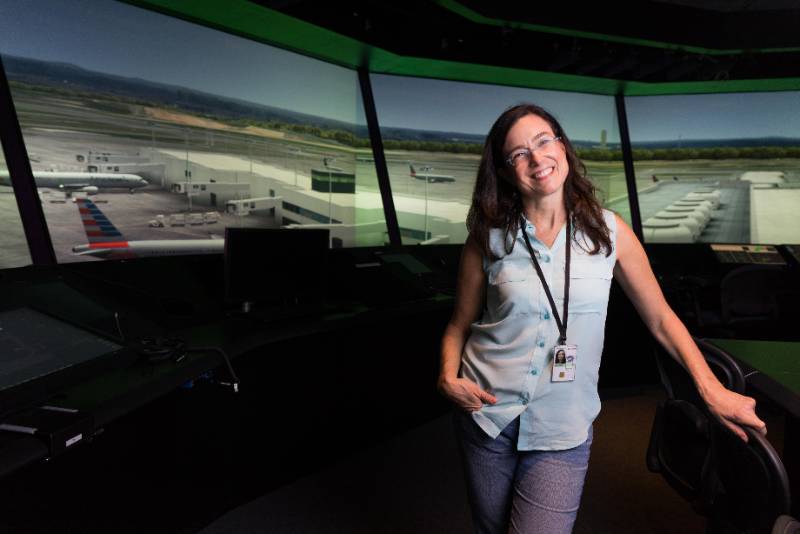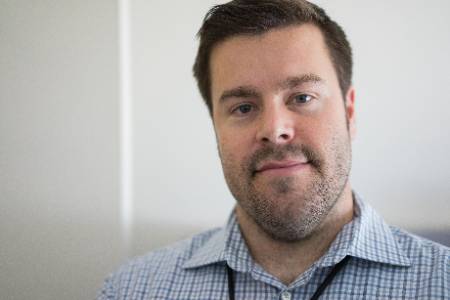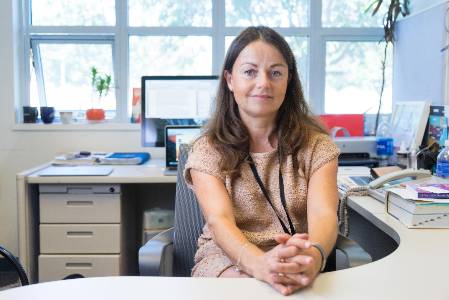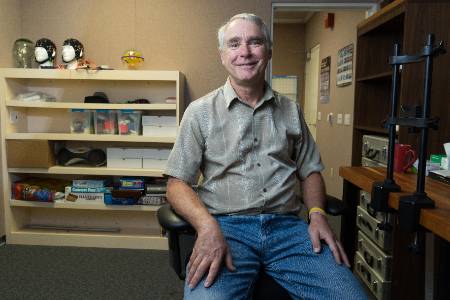The NASA-SJSU Human Factors Partnership
Over the past 30 years, faculty in the SJSU Department of Psychology have
partnered with scientists at the NASA Ames Research Center to conduct collaborative
human factors research: the study of the capabilities and limitations of people as
they interact with their environment, and the application of this knowledge to the
design of human-centered systems and products. The goals are to improve functioning,
efficiency, reliability, and safety, increase satisfaction, and reduce risk and error.
Meet the researchers here:
Victoria Dulchinos

"We are trying to minimize delay by releasing flights from the gate at the optimal time for scheduling flights into the overhead stream, allowing the air traffic controller to hold and release planes from the gate in an optimal way based on schedules combined with real time information.”
Victoria Dulchinos is explaining her work in the air traffic control simulation facility at NASA Ames, where a 360’ out the window view tower simulator replicates the view from the tower at the Charlotte Douglas International Airport in North Carolina. Dulchinos and her colleagues are developing sophisticated algorithms and a set of tools for use by airline ramp personnel as well as Air Traffic Controllers in the future management of gate scheduling for arriving and departing flights. Their research and the resulting logistical improvements could eventually reduce air traffic congestion, fuel emissions and on-board waiting times for passengers after their flights arrive.
“Basically, we’re trying to make something useful happen for everybody.”
Conrad Rorie
 Conrad Rorie investigates ways to integrate unmanned aircraft—also
Conrad Rorie investigates ways to integrate unmanned aircraft—also
called drones—into the same airspace as manned aircraft. His research is not about
small drones that might one day drop a package at your door. Rather, he focuses on
large aircraft like Global Hawks and Reapers, which typically fly at 60,000 feet (versus
commercial aircraft flying at 28,000 to 35,000 feet) and travel longer distances.
"These unmanned aircraft carry sensors that can pick up the position of nearby traffic, which allows onground human pilots to safely maneuver their aircraft around potential conflicts using an electronic display of traffic information.”
In addition to their military applications, unmanned aircraft are used for cargo transport, aerial photography, agriculture surveys, and border security. They also perform reconnaissance over fires and hurricanes in support of emergency responders.
Martine Godfroy-Cooper
 In NASA’s Advanced Controls and Displays laboratory, Martine Godfroy-Cooper focuses
on developing and prototyping multimodal human-machine interfaces for Army helicopter
pilots operating in degraded visual environments.
In NASA’s Advanced Controls and Displays laboratory, Martine Godfroy-Cooper focuses
on developing and prototyping multimodal human-machine interfaces for Army helicopter
pilots operating in degraded visual environments.
Godfroy-Cooper is working on the integration of spatial sound into the cockpit displays of Black Hawk utility helicopters, to complement or substitute for visual cues provided by the sensors.
"Integration of three modalities in human-machine interface—visual, auditory and tactile—enhances human perception and performance. It also reduces workload and improves safety in critical environments.”
Using spatialized sonifications (sounds that convey information relative to the nature or the status of an object) will increase overall situation awareness and enhance obstacle detection and avoidance mechanisms, particularly when the helicopters are hovering or flying in brownout conditions. Other applications include communications segregation, hostile fire warning, and landing aids.
Kevin Gregory
 Fatigue management research examines how sleep loss, changes to the body clock and
duty, and rest hours affect safety in high-performance work settings. At NASA Ames,
this research focuses on pilots and astronauts and their ability to obtain optimal
rest during operations.
Fatigue management research examines how sleep loss, changes to the body clock and
duty, and rest hours affect safety in high-performance work settings. At NASA Ames,
this research focuses on pilots and astronauts and their ability to obtain optimal
rest during operations.
In a lab equipped with darkened experimental bedrooms, Kevin Gregory conducts performance tests on human subjects to determine the effects of fatigue on the human brain. Sleep-wake cycles are tracked using scientific-grade wrist-worn devices, caps with sensors measure brain activity, and reaction times are evaluated.
Gregory and his team explore these questions with the goal of developing practical strategies for increasing safety and improving performance in round-the-clock work.
"We are looking at how performance is affected by the physiological effects of sleep loss. How many days in a row should a pilot work? How much rest is needed between shifts? And for what length of time is it safe for them to work?”
SJSU Research Foundation Annual Report 2016-17